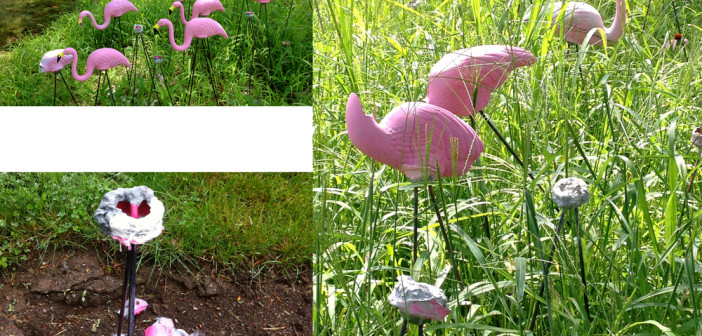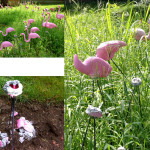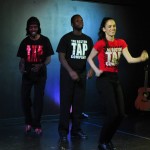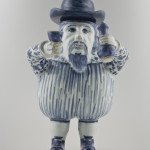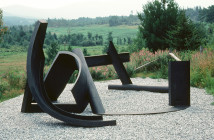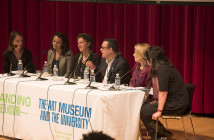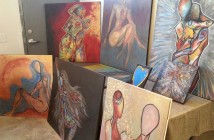While writing this series, I have had conversations with people from all facets of Boston’s arts ecosystem about the concept of Boston as an "innovation hub" and the role that art might play therein. While I’ve spoken with curators, artists, and nonprofit leaders for my posts here at BR&S, the informal conversations I’ve had surrounding the series — in emails from readers, coffee meetings, and serendipitous exchanges — have involved people across fields, from academics to corporate figures. The energy surrounding the issue is palpable, and particularly in the context of City Hall’s moment of transition, Bostonians are eager to discuss the future they envision for the city’s creative communities. As the series comes to a close, I wanted to reflect on some of the themes of these conversations and the opportunities that such discussions suggest for continuing integration of art into Boston’s infrastructure of innovation.
A major theme throughout my conversations has been the unique strengths that Boston offers because of its longstanding identity as a hub for education and knowledge production. While cities throughout the nation seek the help of consultants and strategic "culture-led development" in order to brand themselves as creative hubs, Boston can claim a true heritage of intellectual exchange and creative production. In an economy that increasingly treats ideas and insights as commodities, the value of this heritage should not be underestimated; the challenge for Boston will be convincing decision-makers to look past immediate profitability in favor of the long-term benefits that fostering a true culture of innovation brings to civic life. Interestingly, many of the artists and other art-world figures I have talked to cite the intellectual rigor that Boston provides as a crucial element of their creative processes, noting that this culture distinguishes Boston’s artistic milieu from that of other cities. While people often see art as divorced from intellectual knowledge or other disciplines, inherent connections have always existed between art and knowledge, and Boston should not overlook the unique environment it provides in this respect.
 Andi Sutton, Assisted Flagration, 2013
Andi Sutton, Assisted Flagration, 2013Installation at the DeCordova Sculpture Park and Museum as part of the exhibition Work Out. Image: Andi Sutton.
Much of the language that those in the arts sector use to describe their work is striking in its similarity to the rhetoric that surrounds the innovation hub concept. Artists, curators, arts administrators, and the incredible range of figures who make up the art community are constantly questioning, imagining, reframing, collaborating, highlighting, creating, and, yes, innovating. As Trevor Smith, curator of contemporary art at the Peabody Essex Museum, commented in a conversation for this series, these innovative visions and practices are "about building a culture." In many ways, it seems that the approaches and methodologies of the arts sector are precisely the ways of working that Boston hopes to encourage in other sectors. Just as artists have pointed toward trajectories of change historically, might they be able to point the way toward new ways of conceptualizing the way we work and interact within Boston’s urban environment? Innovation in sectors like medicine and technology has successfully brought Boston into the 21st century, but will integration of artistic practices help drive the city’s continued vitality in the decades to come?
For many people engaged in the business of innovation, this idea seems promising. My conversations suggest that some of the drivers of the city’s "innovative" industries, from tech start-ups to healthcare, are starting to recognize the deep connections between their goals and the practices of Boston’s art community. Somewhat to my surprise, news of burgeoning art/tech collaborations arrived in my inbox following my initial "Art in the Innovation Hub" post, and people from a variety of fields expressed interest in talking more about the concept. The conversations that have come out of these exchanges have suggested real possibility for increased integration of the arts into the wider framework of innovation in Boston. Businesses may want to place contemporary art in their offices not to signal status, but to challenge their employees and encourage them to think in new ways. Organizations working far from the traditional art world are beginning to think about artist-in-residence programs and the possibilities of mutually beneficial collaboration with the arts sector. Tech start-ups, competing fiercely for top talent, are integrating Boston’s cultural offerings into recruitment and retention strategies, and are finding that the benefits of this engagement go beyond employee satisfaction. Across sectors, Bostonians are eager to consider the possibilities of integrating art into the innovation hub and see opportunities that transcend the surface-level instrumentalization of "creative class" economic strategies, instead pointing to real change in the culture of the city at the levels of social and professional dialogue.
In order to realize this potential, the city at large will need to invest in the infrastructure needed for the arts to continue to thrive in Boston. Throughout my conversations, the lack of infrastructure for artists and the challenges of living and working in Boston for those in creative fields emerged as consistent themes. While I discussed issues of infrastructure as they relate to nonprofits in my last post, these questions need to be addressed at every level, from housing and studio space to the art market. Although I did not explicitly cover for-profit art spaces and businesses in the series, what many see as the primary challenge for these spaces — the lack of a strong, adventurous collector base in Boston — has direct links to the changes that many in Boston are calling for. From for-profit galleries and large museums to emerging artists and small nonprofits, the creative sector should be seen as an ecosystem, and the nuances and implications of investing in infrastructure for this sector should be considered in the city’s approach to innovation. If Boston residents understand contemporary art as an essential element of civic life, and the city recognizes the role of artists as innovative workers, galleries and other for-profits as creative local businesses, and art spaces as natural hubs for idea exchange and collaboration, there is tremendous potential for art to be integrated into the innovation hub framework. This comprehensive approach will foster sustainable, meaningful creativity going forward.
Boston is currently facing an incredibly exciting moment. The arts sector made its voice heard in recent elections, and the community continues to explore possibilities for ongoing collaboration and advocacy. The region’s universities are rethinking learning in ways that emphasize creativity, with interdisciplinary centers integrating the arts into intellectual processes and tangible action on campus and in the Greater Boston area. Museums and art spaces are providing places for the conversations and new experiences that can drive great ideas. Artists are drawing from the incredible intellectual offerings of the city and providing models of innovative thinking while businesses seek ways to engage with this environment. If Boston wants to leverage this energy and establish itself as a sustainable innovation hub, it must recognize the contributions of art and foster a healthy arts environment. Rhetoric can only go so far — the integration of art into frameworks for innovation is deeply rooted in the very intellectual traditions that help compose Boston’s heritage, and as the city seeks to unite this heritage with ongoing innovation, the current conversation on art’s role in the city must lead to action. Based on my conversations around this series and the city’s growing creative energy, Boston is ready for this action.
- Andi Sutton, Assisted Flagration, 2013 Installation at the DeCordova Sculpture Park and Museum as part of the exhibition Work Out. Image: Andi Sutton.
- From the Dorchester Arts Collaborative. Courtesy of DAC.
- From Michael Lin’s Freeport Museum at the PEM. Courtesy Peabody Essex Museum.

